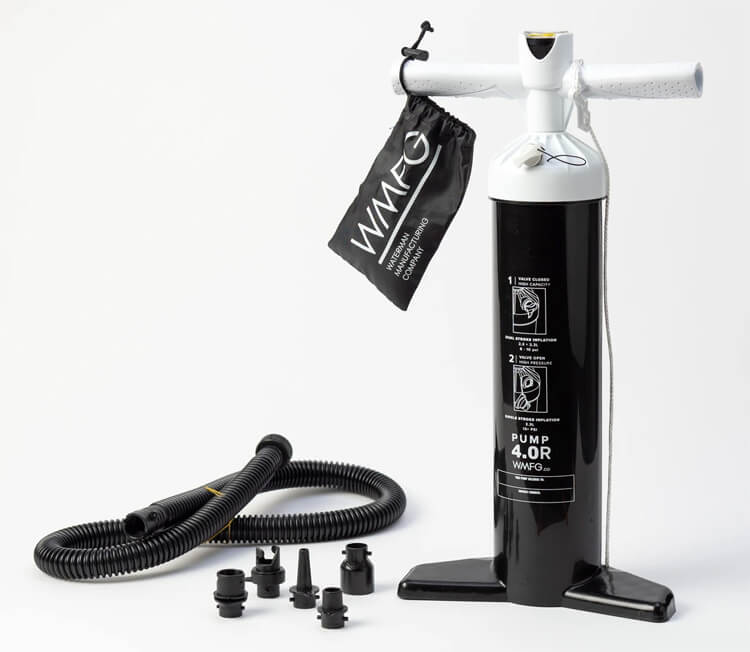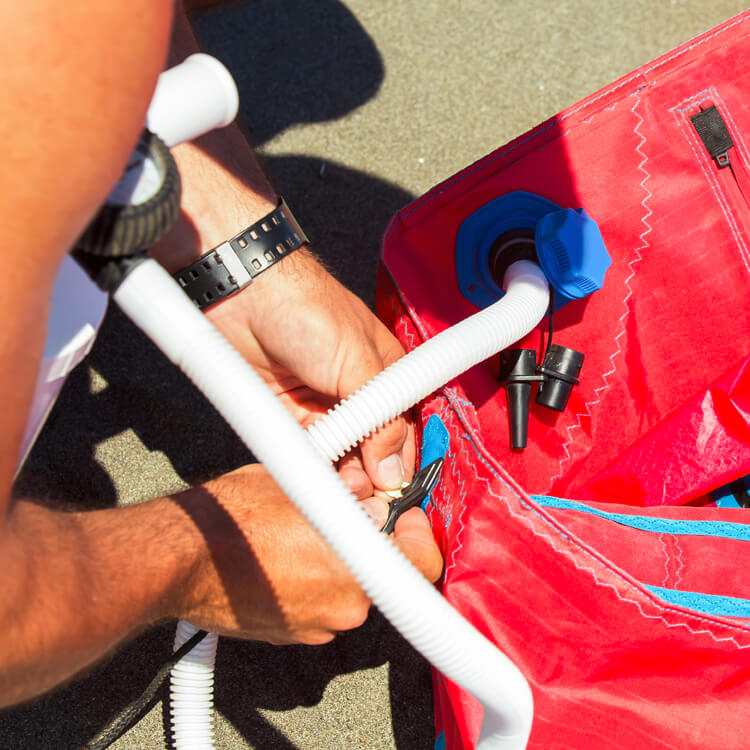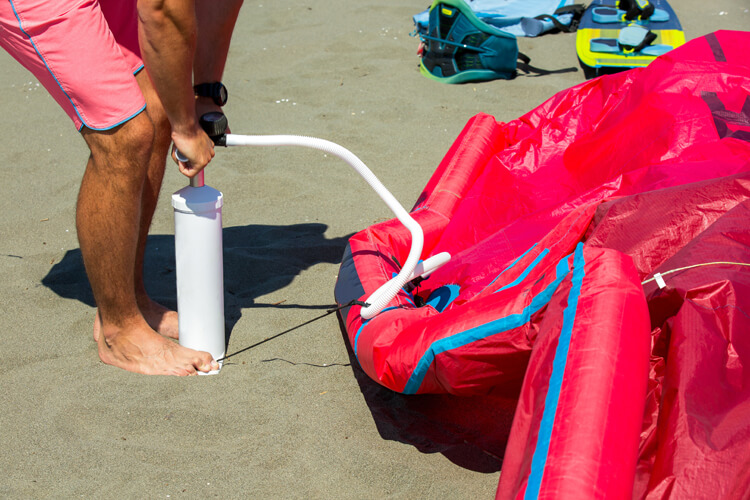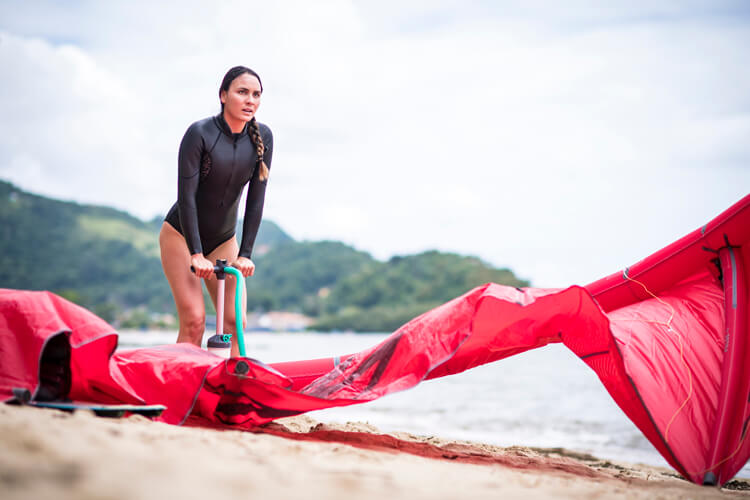How do you choose a good kite pump? What general care and maintenance steps do you need to follow to make it last longer?
Rigging up a kite is a fundamental skill every kiteboarder should master.
The entire process could take a few minutes and involves several pieces of equipment and gear. There's no room for error.
The faster you rig your kite, the more you'll sail.
The best place to inflate your kite - and the most common - is on the beach or grass.
In the end, you'll want your kite to be sufficiently pumped to the manufacturer's pounds per square inch (PSI) pressure recommendation.
Kite pumps are one of the most underrated kiteboarding items, but they're an essential tool in every kiteboarder backpack.
While it is true that pumping a kite is not the most pleasant part of kiteboarding, it is also inevitable, so riders should do it the right way.
Without this item, you can't pump your kite, launch it, and sail away.

The Anatomy of a Kite Pump
In the past, kite pumps weren't as efficient and functional as today, but in less than a decade, the whole design was revamped.
A modern single-to-double action kite pump system comprises the following replaceable parts:
- Pump chamber;
- Pump shaft;
- Handle;
- Footpegs;
- Pressure gauge;
- Leash;
- Hose;
- Adapters and spare parts;
- Seals and anti-sand filters;
- Single-to-double stroke inflation switch;
There are several kite pump models and sizes. In volume, they range from two to six liters per stroke.
The most popular kite pumps feature footpegs facing the rider, an ergonomic handle, a flexible, long-lasting hose, and an easy-to-read pump gauge.
The taller models - in the three-liter range - are less comfortable for shorter riders because when they're pulling the pump up, the handle might get too high.
Most kite pumps come with several accessories, including pump adapters, so they'll work with any kite model or brand.
Some kite pumps have a valve adjuster to make them a two- or one-way pump, and they will even work on inflatable stand-up paddleboards (SUP).
The overall design doesn't change much from manufacturer to manufacturer, but the quality of the materials and plastics should be considered.
Double kite pumps are less popular, but they create a lot of air and are sturdy and comfortable.

What Makes a Good Kite Pump?
Modern kites are equipped with inflate/deflate valves connected to bladders and struts.
After unpacking the kite, unrolling, and securing it, you connect the pump leash and fill the whole structure or skeleton with the right air pressure.
And that's when you can really assess the performance of the inflating device.
A high-end kite pump must be efficient, provide a large volume of air at each stroke, and be well sealed.
As a general rule of thumb, the wider the shaft, the more air is pumped on each stroke.
The best kite pumps inflate while pumping up and down and generate low friction between the shaft and the chamber's tube.
A smart ergonomic shape and design is critical, as well as a precise and reliable air pressure gauge.
A good premium kite pump will also automatically switch from double to single-action inflation as the pressure increases, for example, above six PSI.
Finally, it must also be built from resistant materials to stand the test of sand, wind, and salt water.
The accessories - leash, hose, nozzle, and adapters - should also be ready to be fully functional in high wind conditions.

Kite Pumping Tips
Kite pumps can be sensitive, so you need to know how to use them correctly.
The first thing you need to know is that you should always use both hands and feet to operate it.
If you don't have a pump leash, hold the bridle/5th line or even the front tube while pumping with one of your hands centered.
In the end, you want to have enough pressure so that the kite keeps its shape and doesn't fold.
It is recommended that you adopt even pumping strokes to avoid breaking the plastic handle or base.
Remember that pumping involves friction, and so it generates heat. If you notice the components are getting hot, make a 30-second pause.
Electric kite pumps and compressors may speed up inflation time, but they're generally not a good idea and have never quite gained universal acclaim.
A standard quality kite pump ranges from $40 to $60, but an electric kite pump could reach $600.
WMFG, Slingshot, Mystic, Cabrinha, F-One, North, Naish, and Core are some of the best kite pump manufacturers.
Kite Pump Maintenance
Traditionally, kite pumps never last long due to several technical issues.
In most cases, the interaction between sand grains and friction dries out the lubricant around the shaft, and the pump loses its initial efficiency.
Also, the hose starts leaking, and the whole structure and seals become no longer airtight.
One thing is certain: the less efficient the kite pump, the more exhausted you'll feel after filling the bladder with air.
So, keeping your kite pump clean and fully functional is paramount, and that requires regular maintenance.
Remember that a kite pump is always near - or in contact with - sand and salt water, so you'll need to remove dirt, grease, unwanted residue, and other corrosive elements from time to time.
Depending on the generation of kite pumps you're using, you might want to unscrew its top cap and pull the whole pump off in order to clean it.
Once you've done that, rinse the chamber with fresh water, and dry it with paper towels.
Then, clean the pump shaft and the o-rings with a dry cloth.
Finally, lubricate the inside chamber, the pump shaft, and the o-rings with lithium grease, re-install the pump and close the cap.
Check whether you've got airflow coming out of both directions, and you're good to go.
One of the things you really need to pay attention to is the hose. If you don't take care of it, it will not last long.
Never take the hose and wrap it around your kite. Make sure you fold it every time you finish your session.
Remember to store the kite pump inside a clean bag or container after using it.
